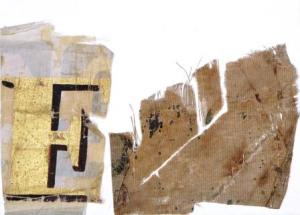The part played by The Black Watch in the Egyptian Campaign of 1801, and particularly the battle of Alexandria, marked an important step in the ever-growing reputation of the Regiment. One incident in the battle of Alexandria concerned the capture of a standard by The Black Watch, fragments of which are on display in the French Wars Gallery in the Museum. These fragments are December’s object of the month. Split in to two main sections, one fragment has the letter ‘E’ written in yellow/gold writing, and outlined in
black. On the reverse is the edge of the letter ‘T’ and another, indistinguishable, letter.
Said at the time to have belonged to a unit known as the ‘Invincible Legion’, the Standard became a source of controversy.
During the battle, the standard was surrendered by a French officer to Major James Stirling, commanding The Black Watch. The standard was given to a sergeant to guard but he was overcome by French cavalry, who in turn lost it to a Private Lutz of the Minorcan Regiment who were fighting alongside The Black Watch.
Alexandria was the first significant land victory by the British against Napoleon and much was written about it, including the circumstances surrounding the capture of the standard. Because of the confusion around the capture, loss and re-capture of the Standard, it was some time before there was recognition of this accomplishment of The Black Watch. Eventually the Highland Society of London presented the Regiment with a magnificent silver vase to mark their contribution to the battle. This too can be seen on display alongside the fragments of the standard.
In 1811 the standard was deposited in the Royal Hospital Chelsea along with a number of other trophies. In 1894 an eye-witness said that there was not much left of the standard but that what was still visible was consistent with this being the standard of a battalion of light infantry of the Army of Italy period.
Stewart of Garth was wounded at the battle and heavily involved in all the debates leading up to the presentation of the Highland Society Vase to The Black Watch. He sums up the episode well:
“The truth is, the thing was not worth a dispute. Those who carried the colour given to Major Stirling were annihilated; and it neither added to or detracted from the character of the 42nd that the colour was subsequently lost by the misfortune or stupidity of an individual. The question was not whether a colour or a drumstick was taken. This supposed invincible corps was conquered; in this the 42nd had their share, and this standard fell accidentally into their hands in consequence of their being so much mixed and so closely engaged with the enemy. The standard which the sergeant of the 42nd had in his possession was lost by him; the standard of which the soldier of Stuart’s (Minorcan) regiment got possession is preserved, and is now in Whitehall; and there the business rests.”
It is worth remembering that the exploits of The Black Watch at this battle and during the whole campaign were quite outstanding, irrespective of the capture or not of a standard.


